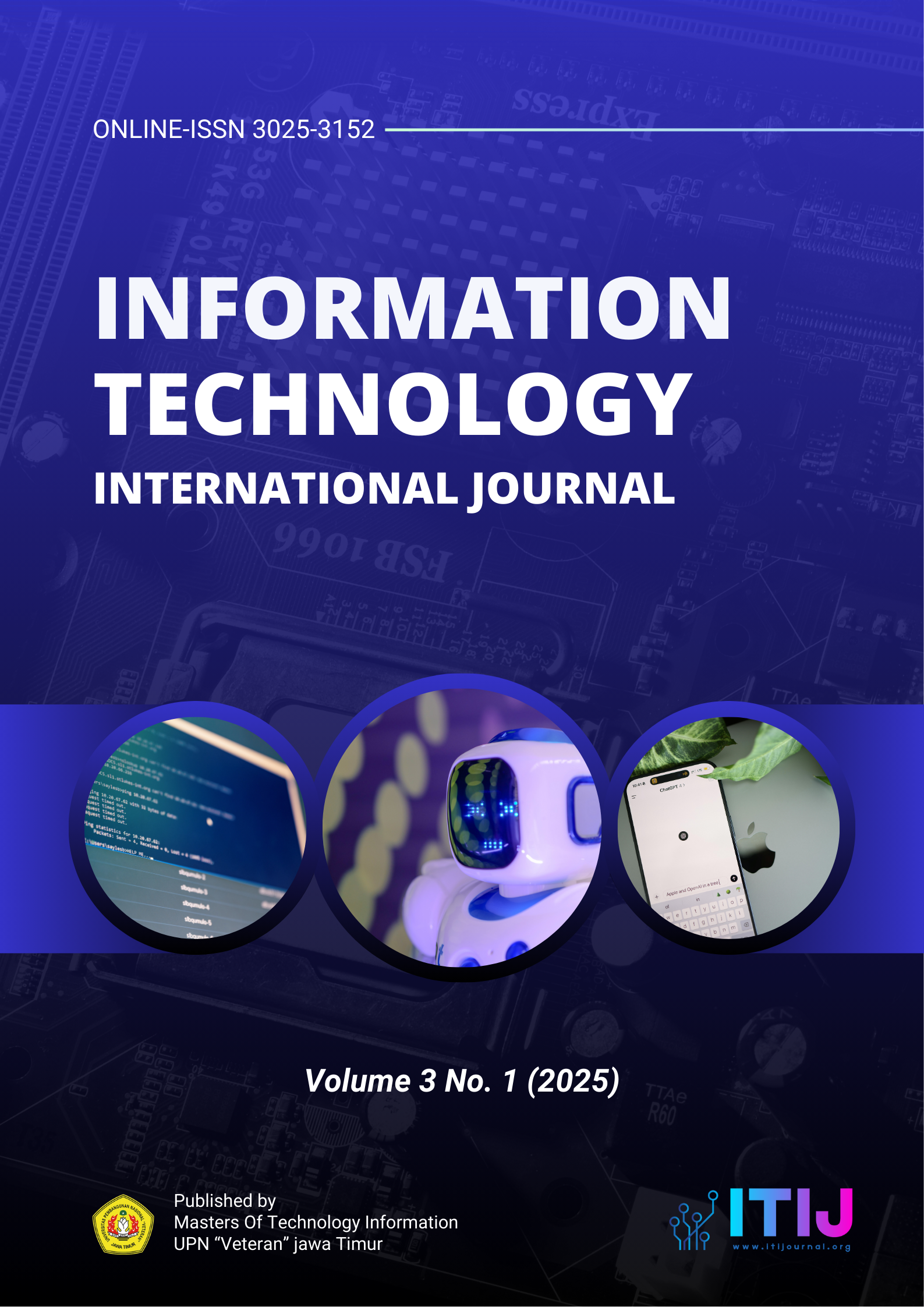Analysis Of Service Quality And User Acceptance Of BMKG Info Application Using EgovQual Model And Technology Acceptance Model (TAM) In Central Java
DOI:
https://doi.org/10.33005/itij.v3i1.51Keywords:
Service Quality, BMKG Application, e-GovQual Model, TAM, PLE-SEMAbstract
This study analyzes the service quality and user acceptance of the Info BMKG application in Central Java, integrating the e-GovQual model and the Technology Acceptance Model (TAM). Using a quantitative survey of 239 Info BMKG users, data was analyzed with PLS-SEM. Findings show the measurement model is highly reliable and valid. Seven of nine hypothesized relationships were statistically significant and positive. Specifically, Perceived Ease of Use (PEOU) significantly influenced both Behavioral Intention to Use (BIU) and Perceived Usefulness (PU). Perceived Usefulness (PU) also significantly impacted Behavioral Intention to Use (BIU). Behavioral Intention to Use (BIU) significantly affected Actual System Use (ATU). For user satisfaction (SAT), Reliability (REL) and Citizen Support (SUP) had a significant positive influence. Actual System Use (ATU) also significantly influenced Satisfaction (SAT). However, the direct influence of Efficiency (EFF) and Trust (TRU) on Satisfaction (SAT) was not statistically significant. These results support the conceptual model and offer valuable insights for enhancing digital public services.. A similar phenomenon is seen in the impact of Trust (TRU) on Satisfaction (SAT), where the high p-value (0.804) and low t-statistic (0.248) indicate that this relationship is also not statistically significant.
Downloads
References
References
[1] D. Primanda, M. Nofrini Burga, A. Juliansyah, and N. Nurfauziah, “Efektivitas Aplikasi Info Bmkg Dalam Memberikan Informasi Cuaca Dan Bencana Terhadap Masyarakat Kota Tangerang Selatan,” Neo Politea, vol. 3, no. 2, pp. 1–9, 2022, doi: 10.53675/neopolitea.v3i2.1013.
[2] F. W. Dewati, A. D. Setiawan, Y. Z. Arief, S. Wilyanti, A. Jaenul, and A. Pangestu, “Analisis Kepuasan Pelanggan terhadap Layanan Aplikasi Sistem Informasi PTSP Online pada Bmkg Pusat Menggunakan Technology Acceptance Model (TAM),” J. Pendidik. Sains dan Komput., vol. 3, no. 02, pp. 161–170, 2023, doi: 10.47709/jpsk.v3i02.2934.
[3] H. Salsabila, D. S. Gabriel, and N. R. Pratama, “Determining Factors Affecting E-Service Quality for Environmental Permits in Indonesia,” no. October 2021, pp. 1–11, 2023, doi: 10.46254/af03.20220091.
[4] P. P. Abdullah, R. Rahmawati, D. I. Sensuse, S. Lusa, A. Arief, and P. Adi, “Evaluasi Kualitas Layanan E-Government Pada Aplikasi Pendaftaran Seleksi Calon Aparatur Sipil Negara Menggunakan Model E-GovQual Berdasarkan Perspektif Pengguna,” J. Teknol. Inf. dan Ilmu Komput., vol. 9, no. 6, p. 1297, 2022, doi: 10.25126/jtiik.2022956130.
[5] D. Akritidi, P. Gallos, V. Koufi, and F. Malamateniou, “Using an Extended Technology Acceptance Model to Evaluate Digital Health Services,” Stud. Health Technol. Inform., vol. 295, pp. 530–533, 2022, doi: 10.3233/SHTI220782.
[6] H. Haryono et al., “Faktor Kesuksesan Smart Mobility Menggunakan DeLone McLean dan E-Government Adoption Models,” J. Tek. Inform., vol. 08, no. 02, pp. 87–99, 2023.
[7] R. T. Prasetio, Y. P. Kristiutami, I. Daspi, R. Priyanto, and F. Hamzah, “Implementasi Model Integrasi Web-Govqual Sebagai Evaluasi Kepuasan Pengguna Berbasis Layanan Masyarakat Terhadap Aplikasi Casualhub,” J. Responsif, vol. 6, no. 2, pp. 222–231, 2024, [Online]. Available: https://ejurnal.ars.ac.id/index.php/jti
[8] C. Sutikno et al., “PENGARUH LITERASI DIGITAL DAN AKSESIBILITAS ONLINE TERHADAP LAYANAN E-GOVERNMENT PADA PELAYANAN ADMINISTRASI DI DINAS,” no. November, 2024.
[9] S. Balaskas, A. Panagiotarou, and M. Rigou, “The Influence of Trustworthiness and Technology Acceptance Factors on the Usage of e-Government Services during COVID-19: A Case Study of Post COVID-19 Greece,” Adm. Sci., vol. 12, no. 4, 2022, doi: 10.3390/admsci12040129.
[10] M. J. J. Gumasing, “Exploring Factors Influencing E-Bike Adoption Among Filipino Commuters: An Integrated Diffusion of Innovation and Technology Acceptance Model,” World Electr. Veh. J., vol. 16, no. 2, 2025, doi: 10.3390/wevj16020113.
[11] A. D. Kusumawardhani and A. Irhandayani, “Pemanfaatan Sistem Informasi Kearsipan Dinamis (SIKD) dalam Menggunakan Technology Acceptance Model,” Anuva J. Kaji. Budaya, Perpustakaan, dan Inf., vol. 4, no. 3, pp. 355–370, 2020, doi: 10.14710/anuva.4.3.355-370.
[12] A. S. Agung, A. A. Fauzi, A. A. Nur Risal, and F. Adiba, “Implementasi Teknik Data Mining terhadap Klasifikasi Data Prediksi Curah Hujan BMKG Di Sulawesi Selatan,” J. Tekno Insentif, vol. 17, no. 1, pp. 22–23, 2023, doi: 10.36787/jti.v17i1.955.
[13] K. Setyowati, P. S. Adi, R. Suryawati, H. Parwiyanto, and S. G. Prakoso, “Effect of E-GOVQUAL Service Quality on Customer Satisfaction of Public Service Mall Website in Surakarta,” Pakistan J. Life Soc. Sci., vol. 22, no. 2, pp. 38–52, 2024, doi: 10.57239/PJLSS-2024-22.2.004.
[14] M. F. Sodiq and F. Amin, “Sentiment Analysis of BMKG Weather Information Service Using K-Nearest Neighbor Method,” Int. J. Softw. Eng. Comput. Sci., vol. 4, no. 2, pp. 822–835, 2024, doi: 10.35870/ijsecs.v4i2.2881.
[15] A. Widyaningtyas, A. Z. Rahman, and R. S. Astuti, “Dimensi E-Government Service Quality (E-GOVQUAL) Pada Situs https://sibooky.semarangkota.go.id/ DI Kota Semarang,” J. Public Policy Manag. Rev., vol. 12, no. 3, pp. 757–771, 2016.
[16] T. Ramayah, J. A. L. Yeap, N. H. Ahmad, H. A. Halim, and S. A. Rahman, “Testing a Confirmatory model of Facebook Usage in SmartPLS using Consistent PLS,” Int. J. Bus. Innov., vol. 3, pp. 1–14, 2017, [Online]. Available: http://www.theijbi.net/
[17] F. P. Arfian, “Analisis Model E-Govqual Dan Teori Kognitif Sosial Terhadap Niat Lanjutan Dan Kepuasan Pengguna Web Sibakul: Studi Kasus Pada Pengusaha Umkm Daerah Istimewa Yogyakarta,” p. 152, 2022.
[18] K. M. Marcoulides and T. Raykov, “Evaluation of Variance Inflation Factors in Regression Models Using Latent Variable Modeling Methods,” Educ. Psychol. Meas., vol. 79, no. 5, pp. 874–882, 2019, doi: 10.1177/0013164418817803.
[19] S. Wright, “Basics of Path Analysis Wright’s Rules of Tracing and the Fundamentals of Path Analysis,” no. 1992, pp. 1–3, 2023.
[20] E. Edeh, W.-J. Lo, and J. Khojasteh, Review of Partial Least Squares Structural Equation Modeling (PLS-SEM) Using R: A Workbook, vol. 30, no. 1. 2023. doi: 10.1080/10705511.2022.2108813.
Downloads
Published
How to Cite
Issue
Section
License
Copyright (c) 2025 Wahyu Prasetya Adi, Aji Supriyanto

This work is licensed under a Creative Commons Attribution 4.0 International License.
Starting with Volume 3, Issue 1 (2025), all articles published in ITIJ will be licensed under a Creative Commons Attribution (CC BY) license. This new license replaces our previous Creative Commons Attribution-NonCommercial-NoDerivatives (CC BY-NC-ND) license.



